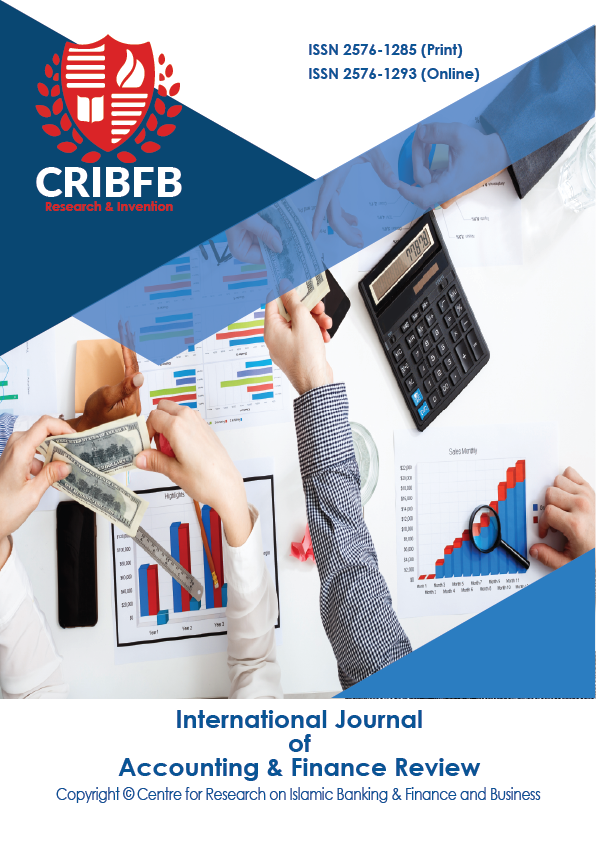Why Non-accelerated Filers Voluntarily Comply with SOX 404b?
Main Article Content
Abstract
This paper investigates the managers’ incentives to voluntarily comply with SOX 404b and the determinants of firms who voluntarily disclose SOX 404b internal control over financial reporting assessment. We find that voluntary SOX 404b reporting non-accelerated filers are more likely to receive effective internal control over financial reporting opinion than accelerated filers and large accelerated filers. We find that voluntary SOX 404b reporting non-accelerated filers are more likely to hire Big Four as independent auditors than non-SOX 404b reporting non-accelerated filers. We also predict and found substantially sufficient cases where non-accelerated filers which used to be, or ex-post became accelerated filers or large accelerated filers, and non-accelerated filers with parent companies complying with SOX 404b are motivated to voluntarily comply with SOX 404b.
Downloads
Article Details
Section
How to Cite
References
Bertomeu, J., Beyer, A., & Dye, R. A. (2011). Capital structure, cost of capital, and voluntary disclosures. The Accounting Review, 86(3), 857-886.
Botosan, C. A. (1997). Disclosure level and the cost of equity capital. Accounting review, 323-349.
Botosan, C. A., & Plumlee, M. A. (2002). A re‐examination of disclosure level and the expected cost of equity capital. Journal of accounting research, 40(1), 21-40.
Bronson, S. N., Carcello, J. V., & Raghunandan, K. (2006). Firm characteristics and voluntary management reports on internal control. Auditing: A Journal of Practice & Theory, 25(2), 25-39.
Cao, Z., & Narayanamoorthy, G. S. (2011). The effect of litigation risk on management earnings forecasts. Contemporary Accounting Research, 28(1), 125-173.
Cheynel, E. (2013). A theory of voluntary disclosure and cost of capital. Review of Accounting Studies, 18(4), 987-1020.
Coles, J. L., Loewenstein, U., & Suay, J. (1995). On equilibrium pricing under parameter uncertainty. Journal of Financial and Quantitative analysis, 347-364.
DeAngelo, L. E. (1981). Auditor size and audit quality. Journal of accounting and economics, 3(3), 183-199.
Diamond, D. W., & Verrecchia, R. E. (1991). Disclosure, liquidity, and the cost of capital. The journal of Finance, 46(4), 1325-1359.
Dopunch, N., & Simunic, D. (1982). The competition in auditing an assessment fourth symposium on auditing research. University of Illinois.
Francis, J., Nanda, D., & Olsson, P. (2008). Voluntary disclosure, earnings quality, and cost of capital. Journal of accounting research, 46(1), 53-99.
Francis, J. R., Khurana, I. K., & Pereira, R. (2005). Disclosure incentives and effects on cost of capital around the world. The accounting review, 80(4), 1125-1162.
Gao, F., Wu, J. S., & Zimmerman, J. (2009). Unintended consequences of granting small firms exemptions from securities regulation: Evidence from the Sarbanes‐Oxley Act. Journal of Accounting Research, 47(2), 459-506.
Grundfest, J. A., & Bochner, S. E. (2006). Fixing 404. Mich. L. Rev., 105, 1643.
Hanley, K. W., & Hoberg, G. (2012). Litigation risk, strategic disclosure and the underpricing of initial public offerings. Journal of Financial Economics, 103(2), 235-254.
Holmstrom, B., & Kaplan, S. N. (2003). The state of US corporate governance: What's right and what's wrong?. Journal of Applied Corporate Finance, 15(3), 8-20.
Houston, J. F., Lin, C., Liu, S., & Wei, L. (2019). Litigation risk and voluntary disclosure: Evidence from legal changes. The Accounting Review, 94(5), 247-272.
Iliev, P. (2010). The effect of SOX Section 404: Costs, earnings quality, and stock prices. The journal of finance, 65(3), 1163-1196.
Jones, D. A. (2007). Voluntary disclosure in R&D‐intensive industries. Contemporary Accounting Research, 24(2), 489-522.
Kim, J. W., & Shi, Y. (2011). Voluntary disclosure and the cost of equity capital: Evidence from management earnings forecasts. Journal of Accounting and Public Policy, 30(4), 348-366.
Kinney, JR, W. R., & Shepardson, M. L. (2011). Do control effectiveness disclosures require SOX 404 (b) internal control audits? A natural experiment with small US public companies. Journal of Accounting Research, 49(2), 413-448.
Lang, M. H., & Lundholm, R. J. (2000). Voluntary disclosure and equity offerings: reducing information asymmetry or hyping the stock?. Contemporary accounting research, 17(4), 623-662.
McMullen, D. A., Raghunandan, K., & Rama, D. V. (1996). Internal control reports and financial reporting problems. Accounting Horizons, 10(4), 67.
Nondorf, M. E., Singer, Z., & You, H. (2012). A study of firms surrounding the threshold of Sarbanes–Oxley Section 404 compliance. Advances in Accounting, 28(1), 96-110.
Pong, C., Nagy, A. L., & Cenker, W. J. (2007). Accounting firms cautiously maneuver in the new audit environment–a note. Managerial Auditing Journal.
Raghunandan, K., & Rama, D. V. (2006). SOX Section 404 material weakness disclosures and audit fees. Auditing: A Journal of Practice & Theory, 25(1), 99-114.
Ribstein, L. E. (2002). Market vs. regulatory responses to corporate fraud: A critique of the Sarbanes-Oxley Act of 2002. J. Corp. L., 28, 1.
Romano, R. (2004). The Sarbanes-Oxley Act and the making of quack corporate governance. Yale LJ, 114, 1521.
Schoenfeld, J. (2017). The effect of voluntary disclosure on stock liquidity: New evidence from index funds. Journal of Accounting and Economics, 63(1), 51-74.
Shroff, N., Sun, A. X., White, H. D., & Zhang, W. (2013). Voluntary disclosure and information asymmetry: Evidence from the 2005 securities offering reform. Journal of Accounting Research, 51(5), 1299-1345.
Securities, U. S. (2004). Exchange Commission (SEC). 2003. Acceleration of periodic report filing dates and disclosure concerning website access to reports. September, 5.
Verrecchia, R. E. (1983). Discretionary disclosure. Journal of accounting and economics, 5, 179-194.
Welker, M. (1995). Disclosure policy, information asymmetry, and liquidity in equity markets. Contemporary accounting research, 11(2), 801-827.
Zhang, I. X. (2007). Economic consequences of the Sarbanes–Oxley Act of 2002. Journal of accounting and economics, 44(1-2), 74-115.




